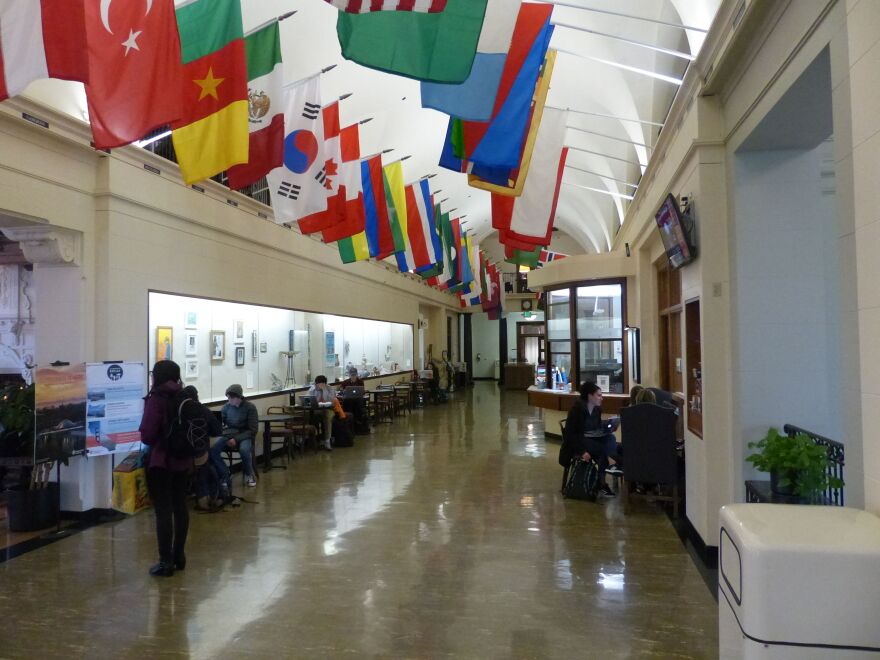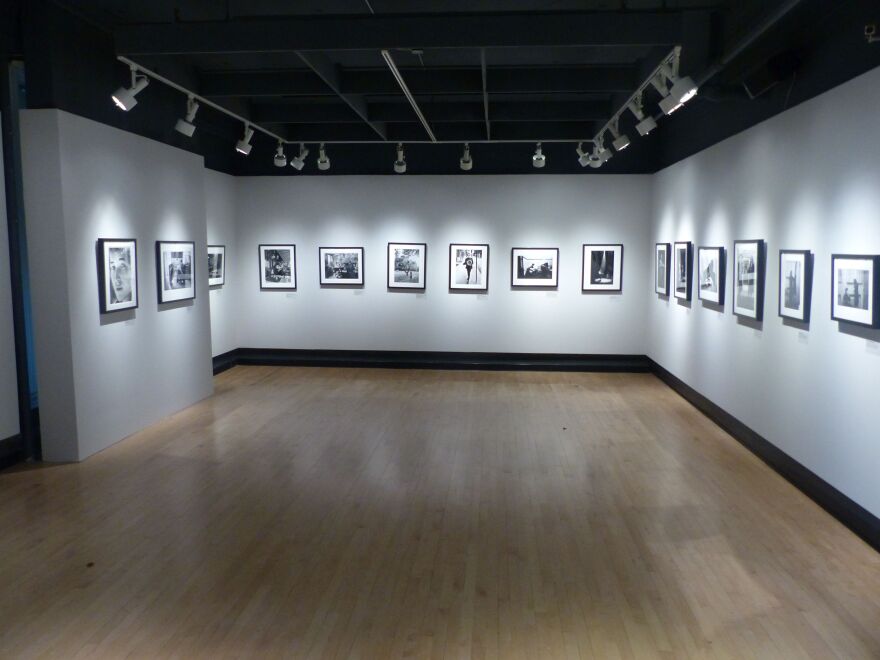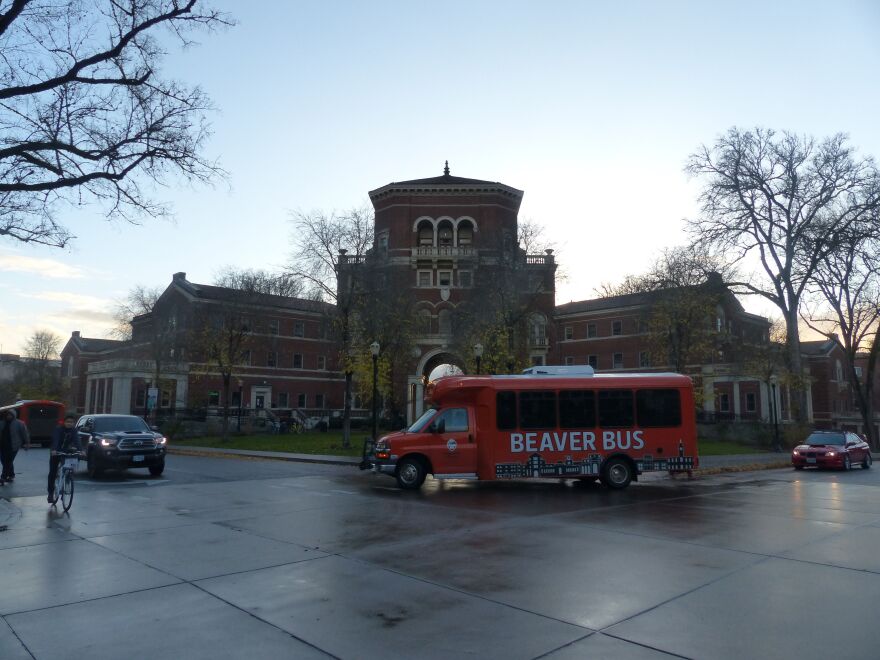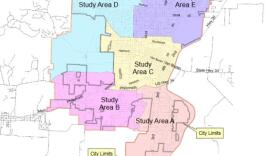As part of our 50th Anniversary Road Trip series, KLCC’s Tiffany Eckert takes us on a walking tour of Oregon State University in Corvallis. The institution is in the midst of Sesquicentennial celebrations.
As one of the oldest colleges on the west coast, OSU has a lot to tout and it does --on its website.
Hear website: ”For 150 years, we’ve been out there…”
OSU is one of the top 50 Research Universities in the country. #1 in Oregon. It’s home of the state’s NASA Space Grant Consortium. Nobel Prize winner Linus Pauling is an alumnus.

The best way to learn the history of a place is to go there. So I visit Larry Landis on the main campus. He’s the lead archivist here. We meet in the Valley Library (hear introductions) then set out walking across the quad. We stop half way.
Reporter: “While we’re standing here, do you smell that”
“Yeah, it’s probably our fireplaces in the Memorial Union,” Landis says. “We should go in and get warm.”
“This is OSU’s living room,” Landis says. “The main lounge in the Memorial Union. It’s a very popular place to hang out, to study or check Facebook or taking a nap in here as well. And that’s how it’s been since this building opened in 1928.”
(hear crackling fire)

Several students have found the warmest spot in the room around the fireplace. A single Persian rug covers the entire floor, nearly 3,000 square feet.

Walking through the OSU main campus, it’s easy to appreciate the planning and consideration that went into its design. Architecturally, it is unified throughout with fenestrated buildings of red brick and terra cotta.
Landis gets into the history of how OSU started.

“Basically what happened was an existing college, Corvallis College, was designated as the state’s Land Grant institution,” says Landis. “The intent was to provide educational opportunities to the common people.”
In its time, OSU has changed names plenty. And there was a common term used in several of them…
“State Agricultural College, Agricultural College of the State of Oregon, Corvallis Agricultural College, Oregon Agricultural College…”
Landis says, depending on one’s perspective this was a plus or a negative.
“Agriculture has always been a major program here,” Landis says. “But as the 20th century progressed there were other areas in the curriculum that were just as important.”

He cites Forestry and Engineering as examples. And, in 1961 the school added ‘University’ to its name.
“We’re walking toward Waldo Hall which was built in 1907 as a women’s dormitory.”
Reporter: “When did the first woman enroll?

“Oregon State, or Corvallis College as it was known in 1868 has been co-educational from the start,” says Landis. “We’ve always been co-educational and that’s a point of pride. In fact our first graduating class was one third female. Three people, one female.”
Today, 46% of undergraduate students are women.

Like the U of O and other public institutions around the country, OSU has had to grapple with the legacy of racism. Last November, OSU President Ed Ray decided to change the name of one of its oldest buildings, Benton Hall. Landis says the name was given to honor 19th century Benton County citizens who raised the money for the building. But…
“Benton County in turn is named for Senator Thomas Hart Benton of Missouri who carried a lot of controversial baggage in terms of race relations,” says Landis. “And certainly his relations to indigenous peoples and Manifest Destiny in general.”
Landis says there is still the question of how to give cred to the early residents of Benton County and leave the racist associations behind.

OSU may be known for its science, engineering and Ag programs but Landis points out the Arts are alive and well here too.
“We started teaching photography in 1891,” Landis says. “Which is probably longer than most college and universities in the nation, especially on the west coast.”
OSU has produced Pulitzer Prize winners and a National Geographic Editor in Chief. David Gilkey— the NPR photojournalist who was killed on assignment in Afghanistan-- studied here.
“Took photographs for the newspaper and the yearbook,” says Landis. “In fact his parents just recently established an endowment to fund two scholarships in David’s name.”
At Cauthorn Hall, the music of Bob Dylan wafts through the air. This is where the Grammy Museum Dylan Photo collection is up. Only two schools in the country were chosen for the exhibit.

Another achievement touted in 150th anniversary marketing materials is this: Oregon State University is now the largest public university in the state.

“For a couple of reasons, we have two branch campuses,” says Landis. “One our Marine Science Center over in Newport and our branch campus in Bend. Plus we have a very, very robust on-line program.”
All told, 31,000 students attend OSU. And, Landis says there is room to grow.
(students walking and street sounds)

“We’ve been here for 150 years and we’ll be here for at least another 150 years,” says Landis. “We are the state university. We really do serve the people of Oregon.”

OSU will continue its sesquicentennial celebration through August 2018.
Production and photo credit to KLCC's Hal Hermanson.










